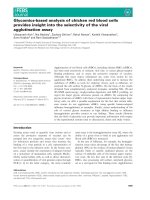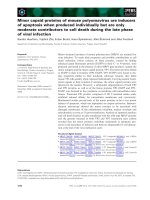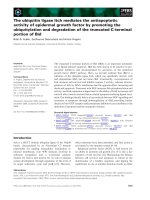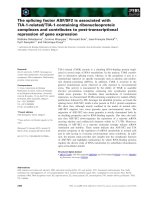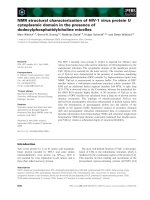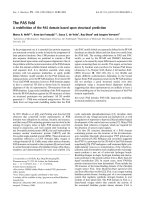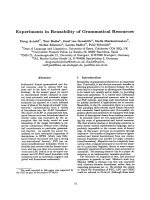Báo cáo khoa học: The structural comparison of the bacterial PepX and human DPP-IV reveals sites for the design of inhibitors of PepX activity pot
Bạn đang xem bản rút gọn của tài liệu. Xem và tải ngay bản đầy đủ của tài liệu tại đây (500.15 KB, 10 trang )
The structural comparison of the bacterial PepX and
human DPP-IV reveals sites for the design of inhibitors
of PepX activity
Pascal Rigolet
1
, Xu Guang Xi
1
, Stephane Rety
1
and Jean-Franc¸ois Chich
2
1 Laboratoire de Biotechnologies et Pharmacologie Ge
´
ne
´
tique Applique
´
e CNRS, Ecole Normale Supe
´
rieure (ENS) Cachan, France
2 Virologie et Immunologie Mole
´
culaires, INRA, Jouy-en-Josas, France
The X-prolyl dipeptidyl aminopeptidases (X-PDAP)
are enzymes that remove X-Pro dipeptides from the
N-terminus of peptides containing a proline or an
alanine at the penultimate position. They are involved
in various mammalian regulation processes as well
as in serious human diseases. Present in lactic acid
bacteria, which are used for various useful human
activities, they are also found in Streptococci where
they have been proposed to play a role in pathogen-
icity. Enzymes with such specificity are classified into
the clan SC [1] in two distinct families, S9 and S15,
according to structural and functional characteristics
[1].
The type example of the S9 family is DPP-IV. Locali-
zed in the membrane of several cell types such as epi-
thelial or endothelial cells [2], it is identical to the T-cell
activation antigen CD26. DPP-IV is a multifunctional
enzyme of 766 amino acids. The 3D structure of the
cytoplasmic part of the human enzyme was recently
solved at 1.8 A
˚
resolution [3]. It has been shown to
play a role in the activation or degradation of biologi-
cal peptides, peptides hormones and neuropeptides [4,5]
and to interact as a receptor or ligand with various
proteins playing a role in the immune response. The
enzyme has been described as deaminase binding pro-
tein [6] and appears to be associated with CD45 [7].
Keywords
docking; DPP-IV inhibitors; PepX; X-prolyl
dipeptidyl aminopeptidase
Correspondence
P. Rigolet, Laboratoire de Biotechnologies et
Pharmacologie Ge
´
ne
´
tique Applique
´
e CNRS,
Ecole Normale Supe
´
rieure (ENS) Cachan,
61 avenue du Pre
´
sident Wilson, 94235
Cachan cedex, France
Fax: +33 1 47 40 76 71
Tel: +33 1 47 40 68 76
E-mail:
Website:
(Received 21 January 2005, accepted 25
February 2005)
doi:10.1111/j.1742-4658.2005.04631.x
X-prolyl dipeptidyl aminopeptidases (X-PDAP) are enzymes catalysing the
release of dipeptides from the amino termini of polypeptides containing a
proline or an alanine at the penultimate position. Involved in various mam-
malian regulation processes, as well as in chronic human diseases, they
have been proposed to play a role in pathogenicity for Streptococci.We
compared the structure of X-PDAP from Lactococcus lactis (PepX) with its
human counterpart DPP-IV. Despite very different overall folds, the resi-
dues most implicated for X-PDAP activity are conserved in the same posi-
tions and orientations in both enzymes, thus defining a structural signature
for the X-PDAP specificity that crosses the species frontiers of evolution.
Starting from this observation, we tested some inhibitors of DPP-IV on
PepX activity, for which no specific inhibitor is known. We thus found that
PepX was highly sensitive to valine-pyrrolidide with a K
I
of 9.3 lm, close
to that reported in DPP-IV inhibition. We finally used the structure of
PepX from L. lactis as a template for computer-based homology modeling
of PepX from the pathogenic Streptococcus gordonii. Docking simulations
of valine-pyrrolidide into the active site of PepX led to the identification of
key residues for a rational drug design against PepX from Streptococci.
These results could have applications in human health giving new perspec-
tives to the struggle against pathogens.
Abbreviations
DPP-IV, dipeptidyl peptidase IV; DPP-II, dipeptidyl peptidase II; LSQ, least squares; pNA, para-nitro-anilide; POP, prolyl oligopeptidase;
SI, selectivity index; X-PDAP, X-prolyl dipeptidyl aminopeptidase.
2050 FEBS Journal 272 (2005) 2050–2059 ª 2005 FEBS
Involved in various processes such as obesity, tumor
growth, graft rejection and allergic phenomena, DPP-
IV also contributes to maintain glucose homeostasis by
activating insulin [8]. Recently, inhibitors of the enzyme
have been used to treat diabetes mellitus [8].
X-prolyl dipeptidyl aminopeptidase from Lactococ-
cus lactis (PepX) is the type example of the S15
family [1]. The structure of this dimeric enzyme was
solved at 2.2 A
˚
[9]. This enzyme is also found in
pathogenic Streptococci, such as Streptococcus gordo-
nii, responsible for bacterial endocarditis [10], or
Streptococcus agalactiae, the leading cause of neonatal
sepsis and meningitis, where PepX was identified as a
virulence factor [11,12]. Streptococcus pneumoniae and
Streptococcus pyogenes, implicated in several serious
diseases, also possess a PepX-encoding gene, as detec-
ted by systematic genomic sequencing [13,14]. While
PepX from beneficial bacteria are probably involved
in the degradation of milk caseins, proline-rich pro-
teins, the in vivo function of this enzyme in Lactococci
and Lactobacilli is not fully understood [15,16]. As
PepX has been proposed to play an important role
in the virulence [10–12] of pathogens, it could be of
great interest to selectively inhibit this enzyme, to
stop or at least slow down the infectious process of
some Streptococci.
We compared the sequences and the 3D structures
of prokaryotic PepX and eukaryotic DPP-IV. This
study is the first evaluating the effects of evolution on
these distant enzymes sharing the same activity. Based
on this comparison, we tested the effects of some
inhibitors of DPP-IV on the activity of PepX, for
which no specific inhibitor is known. We thus found
that PepX was highly sensitive to valine-pyrrolidide,
with a K
I
close to that reported for DPP-IV inhibition.
We then used the structure of PepX from L. lactis as a
template for computer-based homology modeling of
PepX from the pathogenic S. gordonii. Finally, we pro-
ceeded to docking simulations of valine-pyrrolidide
into the active site of PepX from L. lactis and PepX
from S. gordonii. The identification of key-residues
gives new insights toward a rational drug design
against PepX from Streptococci. These results could
have applications in human health, giving new perspec-
tives to struggle against pathogens.
Results
Comparison of the sequences and structures of
the prokaryotic PepX and the eukaryotic DPP-IV
PepX from L. lactis is a homodimeric enzyme com-
posed of an a ⁄ b hydrolase [17] catalytic domain
(Fig. 1A, green) covalently bound to an N-terminus
and a C-terminal b-sandwiched domain (respectively in
red and blue in Fig. 1A) [9], whereas DPP-IV consists
of an eight-blade b propeller domain and a C-terminal
a ⁄ b hydrolase domain (Fig. 1B) [3,18–22] which forms
the catalytic domain with two small a-helices of the
N-terminal sequence. When compared, the structures
of PepX and DPP-IV do not show any homology
except for their catalytic portion, where it is possible
to superimpose only 140 Ca atoms (around 18% of
PepX and DPP-IV C a positions) with a root mean
square deviation (rmsd) less than 1.0 A
˚
.
The small helical domain, present in all enzymes of
the clan SC and carrying residues important for the
enzyme specificity, seems also to be very specific to
each enzyme as it is clearly of a different size,
AB
DC
Fig. 1. Structures of enzymes of the clan SC. The N-terminal
domain of each enzyme is colored red, the catalytic domain is
green, the helical and smallest domain is orange, the C-terminal
domain (only present in PepX) is blue, and the catalytic triad
is magenta with a ball-and-stick representation. (A) PepX from
L. lactis ssp. Cremoris (1LNS), type example of the S15 family. This
is the only enzyme of the clan SC presenting four domains inclu-
ding a large C-terminal domain. (B) Soluble secreted form of human
DPP-IV (1N1M), type example of the S9B subfamily. (C) Bacterial
cocaine esterase (1JU3). (D) Muscle POP, porcine prolyl oligopepti-
dase (1QFS), type example of the S9A subfamily.
P. Rigolet et al. Sites for the design of inhibitors of PepX activity
FEBS Journal 272 (2005) 2050–2059 ª 2005 FEBS 2051
sequence and frankly different orientations with
respect to the common a ⁄ b hydrolase domain (Fig. 1,
orange). Although the two X-PDAP enzymes are of
the same size (763 residues for PepX and 766 residues
for DPP-IV), the closest structure to DPP-IV is prolyl
oligopeptidase (POP; Fig. 1D) [23], an endopeptidase
specifically cleaving after proline residues and belong-
ing to the same family S9 but having less than 20%
residues in common, whereas the closest structure to
PepX is the bacterial cocaine esterase (Fig. 1C) [24],
which is only composed of two domains. The funnel
in the centre of the b8-propeller domain responsible
for substrate selection in DPP-IV [3,18–22] has no
equivalent in PepX.
These differences are reflected in the low homology
between the sequences of the two X-PDAP enzymes
even when the comparison is restricted only to their
catalytic domains (17.8% identity). Only three
conserved sequences can notably be distinguished
between the sequences of PepX and DPP-IV: a
sequence NxxxAxxGxSYxG around the active serine;
a sequence LxxHGxxDxNVxxxxQxxxxxKAL around
the active aspartic acid; and a sequence AxAxx-
SxWxxY in the helical domain (where ‘x’ represents
any amino acid).
Comparison of the active and specificity sites
in the two X-PDAP enzymes
As emphasized, the differences in the overall structures
and substrate selection between the bacterial PepX and
its mammalian counterpart DPP-IV are both numer-
ous and important. Nevertheless, about two-thirds of
the residues involved in catalysis superimpose with
good accuracy in both structures while the rest are
replaced by more or less equivalent residues positioned
in the same locations of the specificity sites (Fig. 2A,
Table 1).
Beside the two catalytic triads, which correspond
perfectly, the residues Tyr662 in DPP-IV and Tyr380
in PepX (Fig. 2A, Pos1) that ensure the stacking with
the Pro residue of the substrate in the N
)1
position
[3,9,18–22], superimpose almost exactly. This is also
the case for the main chain of the tyrosine residues,
Tyr349 in PepX and Tyr631 in DPP-IV (Fig. 2A,
Oxa1 site), positioned immediately after the catalytic
serine in both enzymes, and involved in the oxyanion
hole. Their aromatic rings are held perpendicular to
each other with the OH group pointing in the same
direction. Moreover, one of the very important gluta-
mic acid residues, Glu206, responsible with Glu205 for
Fig. 2. The X-PDAP signature. This figure
shows the LSQ superimposition of the most
similar residues involved in the specificity of
the enzymes compared. According to the
descriptions of the active sites of DPP-IV
[3,18–22] and PepX [9], the residues involv-
ed in the positioning of the substrate proline
are labelled <Pos1> to <Pos4>, the resi-
dues involved in the oxyanion hole are label-
led <Oxa1> and <Oxa2>, and residues
responsible for the exopeptidase activity are
labelled <Exo1> and <Exo2>. Finally, the
residues postulated to stabilize the sub-
strate when it is positioned in the specificity
pocket are labelled <Stb1> and <Stb2>.
(A) X-PDAP signature resulting from the
comparison of the active and specificity site-
s of the two X-PDAP enzymes, the bacterial
PepX (green) and the human DPP-IV (orange).
(B) Superposition of the active and specifi-
city sites of the S9 enzymes porcine POP
(cyan) and human DPP-IV (orange). The sta-
cking with the substrate proline is ensured
by Trp595 in POP instead of Tyr380 in PepX
or TYR 666 in DPP-IV.
Sites for the design of inhibitors of PepX activity P. Rigolet et al.
2052 FEBS Journal 272 (2005) 2050–2059 ª 2005 FEBS
exopeptidase specificity but also contributing to the
precise positioning of the substrate proline in DPP-IV
[3,18–22], superimposes with good agreement on
Glu396 of PepX (Fig. 2A, Exo1 subsite), which is also
supposed to play a role in specificity [9]. For Glu205,
crucial for inhibition of DPP-IV [3], the superimposi-
tion involves a phenylalanine, Phe393, in the same
region of PepX (Exo2 subsite). As in the case of
Glu205 and Glu206 in DPP-IV, their homologues in
PepX (Phe393 and Glu396, respectively) are close in
the sequence, belonging to a loop detached from the
rest of the molecule. Nevertheless, these structures
come from entirely different domains: the helical
domain in the case of PepX (Fig. 1A, orange) but a
small helix in the N-terminal propeller domain in
DPP-IV (Fig. 1B, red).
In addition, Trp377 in PepX is exactly superimposa-
ble on Trp659 in the catalytic site of DPP-IV (Fig. 2A,
Pos3 subsite). This residue seems to be very specific for
the X-PDAP enzymes as it is not present in other
members of clan SC such as POP (Fig. 2B). We hypo-
thesize that this tryptophan residue could contribute to
the positioning of the substrate. Good correspondence
can also be found for the residues Val470 and Asn471
in PepX that superimpose with residues Val710 and
Asn711, respectively, in DPP-IV (Stb1 subsite and the
next residue). To a lesser extent this is also the case for
Tyr210 in PepX and Tyr547 in DPP-IV present in the
same region of the active site, with the hydroxyl point-
ing in the same direction (Fig. 2A, Oxa2).
Finally, Arg125 (Fig. 2A, Stb1 subsite), judged to
be important for DPP-IV activity [3], has no equival-
ent in PepX, the space occupied by this bulky and
charged residue being totally empty in the bacterial
enzyme.
The residues and subdomains involved in the sub-
strate specificities of other members of the clan SC
whose structures are known show drastic differences
(Table 1). Thus, comparing precisely the specificity
sites of DPP-IV and POP (Fig. 2B), the enzyme that
most resembles DPP-IV (Fig. 1), the similarities appear
curiously lower than in the case of the superimposition
of PepX and DPP-IV catalytic sites. Homologies essen-
tially concern the Pos1, Oxa1 and Oxa2 subsites. The
stacking with the substrate proline is ensured by
Trp595 [23], superimposing only partially with the
Table 1. Equivalent residues in compared enzymes of the clan SC. Labels used are the same as in Fig. 2. Apart from the conserved catalytic
triad, a group of six to 11 residues, depending on the enzyme, are involved in the specificity. These can be divided into four subgroups: the
residues involved in positioning the substrate in the active site (labelled Pos1 to Pos4); residues involved in the stabilization of the substrate
in the active site (Stb1 and Stb2); those forming the oxyanion hole (Oxa1 and Oxa2); and those responsible for the exopeptidase specificity
(Exo1 and Exo2). For each subsite, residues with main chains and side chains superimposing well (rms fit of around 1 A
˚
) are shown in bold,
while those present in the same region with main chain or side chain superimposing relatively well are in normal font. Residues that do not
superpose at the subsite but are present in the same position are underlined. Absence of a residue is indicated ‘–‘. Glu204 and Glu232,
responsible for the SPAP exopeptidase activity, are not superimposable with Exo1 or Exo2 subsites.
Label PepX
(family S15)
DPP-IV
(family S9B)
POP
(family S9A)
SPAP
(family S33)
CBPY
(family S10)
Catalytic triad
Ser S348 S630 S554 S113 S146
Asp D468 D708 D641 D268 D338
His H498 H740 H680 H296 H397
Residues implicated in positioning of the substrate proline in the active site
Pos1 Y380 Y662 W595 – –
Pos2
L401 Y666 F476 E232 W312
Pos3 W377 W659 –
L141 –
Pos4 I374 V656 V580 F139
a
L178
Residues stabilizing the binding of the substrate in the specificity pocket
Stb1 – R125
R643 – Y256
Stb2 N470 N710 R643 A270 I340
Oxyanion hole
Oxa1 Y349 Y631 N555 W114 Y147
Oxa2 Y210 Y547 Y473 – –
Residues responsible for the exopeptidase activity
Exo1 F393 E205 – – –
Exo2 E396 E206 – – –
Other residues postulated to play a role in enzyme specificity
Other V471 V711 V644 C271 C341
a
F139 of the SPAP enzyme occupies Pos4 but plays the same role as the Pos1 subsite (stacking with the substrate proline).
P. Rigolet et al. Sites for the design of inhibitors of PepX activity
FEBS Journal 272 (2005) 2050–2059 ª 2005 FEBS 2053
tyrosine of the Pos1 site (Fig. 2B). The structural dif-
ferences observed between the two peptidases could be
connected with their different specificities.
In vitro inhibition of PepX from L. lactis
Contrary to DPP-IV, no specific inhibitor is known for
the bacterial PepX. One of the immediate conse-
quences of the structural similarities between the two
active sites is to search for putative inhibitors of PepX,
using the knowledge of DPP-IV inhibition as a starting
place. We thus decided to test the effect of some effi-
cient inhibitors of DPP-IV on PepX activity.
PepX was highly sensitive to the DPP-IV specific
inhibitor valine-pyrrolidide, as shown by 50% residual
activity when using a concentration of 30 lm (IC
50
)
and by a K
I
of 9.3 lm (Table 2, Fig. 3A). Comparing
these data with the inhibition experiments for DPP-IV,
the concentration of valine-pyrrolidide inhibiting
PepX is 7.5 times the concentration inhibiting DPP-IV
(IC
50
¼ 4 lm, Table 2), but the K
I
values are close
(Table 2). It should be noted that with a K
I
of the
micromolar range, more precisely 2 lm, the DPP-IV
inhibitor valine-pyrrolidide represents an effective glu-
cose-lowering compound in vivo [25].
The classical inhibitors of DPP-IV diprotin A (Ile-
Pro-Ile) and diprotin B (Val-Pro-Leu) have also been
tested on PepX activity. Both tripeptides had a lesser
effect on inhibiting PepX activity. The IC
50
was found
to be 260 lm for diprotin A and 600 lm for dipro-
tin B, diprotin A being thus nine times less efficient
than valine-pyrrolidide (Table 2, Fig. 3B) whereas
diprotin B is 20 times less efficient than valine-pyrroli-
dide.
The results obtained for diprotin A and diprotin B
could be partly explained by the size of these com-
pounds, fitting less well to some details of the structure
of PepX than smaller ligands such as valine-pyrrolidide
and requiring a more specific binding site that extends
better. In consequence, as observed here, diprotin A or
diprotin B inhibit PepX activity less efficiently.
Docking simulations on X-PDAP enzymes
The results obtained for valine-pyrrolidide encouraged
us to model the docking of the inhibitor into the PepX
active site using the Lamarckian genetic algorithm of
autodock 3.0 [26]. We started from the reference of
the crystal structure of DPP-IV complexed with the
valine-pyrrolidide inhibitor in order to make profitable
comparisons.
We first carried out docking tests of valine-pyrroli-
dide in the DPP-IV active site to validate the efficiency
of the method. As a result, the positions and confor-
mations of the lowest binding energy docked solutions
were found with a frequency of 94% and an rmsd of
1.36 A
˚
, compared with the true crystal structures that
served as references (Table 3). The low rmsd between
Table 2. Inhibition experiments realized with PepX from L. lactis.
All experiments were carried out under the same conditions of pH
8.5 and at 37 °C. IC
50
and K
I
values for PepX were obtained from a
graphical analysis of the results of the experiments (Fig. 3). SI,
selectivity index (PepX IC
50
⁄ DPP-IV IC
50
).
Compound
PepX
IC
50
(lM)
K
I
(lM)
DPP-IV
IC
50
(lM)
K
I
(lM)SI
Valine-pyrrolidide 30 9.3 4
a
2
b
7.5
Diprotin A 260 71.5 8
c
4.6
d
32.5
Diprotin B 600 118.45
a
[28],
b
[3],
c
[36],
d
[20].
Fig. 3. Inhibition experiments. (A) Inhibition of PepX by the DPP-IV
inhibitor valine-pyrrolidide. Values measured for k
cat
are reported in
s
)1
for different concentrations of valine-pyrrolidide. The right axis
shows the residual activity (RA, %). (B) Inhibition of PepX by the
DPP-IV classical inhibitor diprotin A. Values measured for k
cat
are
reported in s
)1
for different concentrations of diprotin A. The right
axis shows the residual activity (RA, %). IC
50
and K
I
values for both
inhibitors have been obtained from analysis of these graphics.
Sites for the design of inhibitors of PepX activity P. Rigolet et al.
2054 FEBS Journal 272 (2005) 2050–2059 ª 2005 FEBS
the docked inhibitor and the reference indicated that
the method was suitable to study real interactions
between substrate and enzyme.
Valine-pyrrolidide was then docked into the active
site of PepX from L. lactis. The results are presented
in Table 3 and Fig. 4A. For the cluster of lowest
energy, both the position and the conformation of the
ligand are close to those observed in the 3D structure
of the complex between DPP-IV and valine-pyrrolidide
[3], serving as reference for the rmsd calculation. The
rmsd was 1.5 A
˚
for this robust cluster obtained with a
frequency of 83% (Table 3). The other solutions, also
found in docking calculations with DPP-IV, were too
far from the original position to be considered as
likely. The value of 9.6 lm computed by autodock
for the K
I
of the solution of the lowest binding energy
(Table 3) is remarkably close to the experimental value
of 9.3 lm found for K
I
in inhibition tests concerning
PepX (Table 2).
The interactions of the bound ligand with the resi-
dues of the specificity site (Fig. 4A) reveal good stack-
ing between the pyrrolidine ring of the drug and the
side chain of Tyr380 (Pos1 subsite), even slightly better
than in the true crystallographic complex formed
between the drug and DPP-IV and involving Tyr666.
As expected from the resemblances between the two
active sites, the OE1 atom of Glu396 forms a hydrogen
bond with the amino terminus of valine-pyrrolidide,
but the additional bond observed in DPP-IV between
the N-terminus of valine-pyrrolidide and the Glu313
side chain is absent. The PepX active site lacks an
equivalent residue to Arg125 from DPP-IV [3,18–22],
Table 3. Docking simulations of valine-pyrrolidide in the X-PDAP enzymes. For each simulation, 150 runs were carried out. The robustness
is given by the frequency of observation of the cluster among all solutions.
Enzyme Source Cluster rank Robustness
Mean docked
energy (kCalÆmol
)1
)KI
b
(lM)
Reference
rmsd
c
(A
˚
)
DPP-IV
a
Human 1 91% )8.4 1.50 1.36
PepX L. lactis 183%)7.2 9.60 1.50
PepX S. gordonii 280%)7.5 7.10 1.70
a
Tests carried out on DPP-IV to validate the computational protocol of AUTODOCK.
b
Mean of values calculated by AUTODOCK 3.0.
c
Mean of
the rmsd calculated between the solutions of
AUTODOCK 3.0 and the reference in the complex ligand-DPP-IV crystal structure.
AB
CD
Fig. 4. Docking simulations. Valine-pyrroli-
dide docked into the active site of: (A) the
crystalline structure of PepX from L. lactis;
(B) the modeled structure of PepX from
S. gordonii. (C) Structure of PepX from
S. gordonii (orange) computed by
MODELLER
software, using homology modeling approa-
ch and superimposed with the crystalline
structure of PepX from L. lactis (green) that
served as the template structure in the
modeling. The rmsd between the two struc-
ture is 0.45 A
˚
(D) Compared positions and
conformations of the ligand valine-pyrroli-
dide. 1, Complexed with DPP-IV in the X-ray
crystallographic structure (considered to be
the reference); 2, docked into the active site
of the human DPP-IV; 3, docked into the
active site of the crystalline structure of
PepX from L. lactis;and4, docked into the
active site of the modeled structure of PepX
from S. gordonii.
P. Rigolet et al. Sites for the design of inhibitors of PepX activity
FEBS Journal 272 (2005) 2050–2059 ª 2005 FEBS 2055
but this does not seem to be essential for the binding
of valine-pyrrolidide in the PepX active site. Here a
unique bond is observed between the carboxyl group
of the ligand and the NH
2
of Asn470 (equivalent to
Asn710 in DPP-IV). Another potential bond can be
proposed between the OH atom of Tyr380 and the car-
bonyl group of the ligand. Finally, the valine side
chain of the ligand, pointing towards the active site
cavity, shows only low hydrophobic interaction with
the side chain of Leu401. These data thus reveal that
PepX and DPP-IV enzymes bind small drugs with
comparable interactions.
Discussion
Comparing the evolutionarily distant bacterial PepX
and human DPP-IV led to the conclusion that most of
the residues implicated in X-PDAP activity are con-
served in the same position in both specificity sites
(Fig. 2A), despite very different domains flanking the
catalytic domain, different dimer organization and sub-
strate selectivity processes. These resemblances are
characteristic of X-PDAP activity, as a broader com-
parison involving all of the known structures of
enzymes belonging to the clan SC has shown that most
of these key residues are only present in X-PDAP
enzymes (Table 1, Fig. 2). This study reveals the exist-
ence of a structural signature of X-PDAP specificity,
crossing the subdivisions among peptidase families.
This particular spatial arrangement is probably the
result of divergent evolution that retained an efficient
site for the release with high specificity of a dipeptide
containing a proline from a polypeptide.
The residues postulated to stabilize the substrate in
the active site of DPP-IV are Arg125 and Asn710. The
arginine residue is not necessary for catalysis in PepX,
where it is replaced by an empty space that constitutes
the most important difference between the bacterial
and the mammalian active sites. Another difference
concerns the residues responsible for the exopeptidase
specificity, namely the two glutamic acids Glu205 and
Glu206 in DPP-IV but Glu396 and Phe393 in PepX.
This observation emphasizes the important role of
Glu396 as already described [9], and reveals a function
for Phe393 in PepX. These positions have been main-
tained in the signature despite structural rearrange-
ments throughout evolution.
The existence of the X-PDAP signature led us to test
inhibitors of DPP-IV on PepX activity for which no
specific inhibitor is known. The inhibitors of DPP-IV
chosen were those of the smallest size. The resem-
blances between the two active sites are well confirmed
by the results of inhibition tests with valine-pyrrolidide.
This compound has been shown here to be an inhibitor
for PepX and docking simulations revealed that the
active site of PepX can accommodate such compounds.
PepX from S. gordonii is a potential virulence factor
in bacterial endocarditis [10]. The amino acid align-
ment of PepX from L. lactis and PepX from S. gordo-
nii gave a sequence identity of 48% and 65%
homology. This enabled us to obtain a realistic model
of PepX from S. gordonii (Fig. 4B,C), with the homol-
ogy modelling approach of the modeller software
[27], using the structure of PepX from L. lactis as pro-
tein template. As shown in Fig. 4C, no important dif-
ferences have been observed between the two PepX
structures. Moreover, the two active sites are highly
conserved (Fig. 4A,B). Docking simulations done with
this modelled PepX gave similar results to the compu-
tations done with the enzyme from L. lactis (Table 3,
Fig. 4B). The ligand valine-pyrrolidide presents the
same interesting interactions, which suggest that it
could also inhibit the streptococcal PepX enzyme.
As DPP-IV is involved in a great variety of physio-
logical processes it is important to avoid adverse reac-
tions. Thus a nonspecific inhibition directed against
the X-PDAP of pathogens would probably affect the
activity of the mammalian enzymes, leading to harmful
consequences for human health. Taking advantage of
the structural differences and similarities between the
mammalian and bacterial specificity sites, potential tar-
gets can be selected designing inhibitors acting specific-
ally on PepX of pathogens but not on DPP-IV of the
infected host.
As revealed by the results of our inhibition tests
with diprotin A or diprotin B, we have found cases
for which inhibitors are much more adapted to one
enzyme (DPP-IV) than to the other one (PepX). Con-
versely, it should be possible to find drugs that inhibit
PepX more efficiently than DPP-IV. Recently, com-
pounds have been found to be more effective on DPP-
II than on DPP-IV activity, with a high selectivity
enabling differentiation between DPP-II and DPP-IV
in biological systems [28].
To obtain compounds inhibiting PepX more effi-
ciently than DPP-IV, advantage could be taken of the
large empty space present in the PepX active site in
place of the important Arg125 residue in DPP-IV
(Fig. 2A). A pyrrolidide derivative that fills, at least
partially, this free space in PepX with a close adapta-
tion to the rest of the active site would probably be
unable to enter into the DPP-IV active site due to
steric hindrance or to the positive charge of Arg125.
Another strategy would be to exploit the difference of
occupancy between Phe393 in PepX and Glu205 in
DPP-IV (Fig. 2A, Exo2 site). The Tyr381-Glu396 loop
Sites for the design of inhibitors of PepX activity P. Rigolet et al.
2056 FEBS Journal 272 (2005) 2050–2059 ª 2005 FEBS
of the helical domain, only present in PepX, could also
be a target to specifically block the bacterial enzyme.
The work presented here could be usefully employed
in the research of treatments of particularly severe dis-
eases involving Streptococci (S. gordonii, Streptococcus
pneumoniae, Streptococcus agalactatiae, Bacillus anthra-
cis), avoiding the damage caused by PepX to host tis-
sues during pathology.
Experimental procedures
Multiple sequence alignment and
superimposition of structures
The sequences and structures of the following enzymes were
compared: CBPY, carboxypeptidase Y from Saccharomyces
cerevisiae (1CPY) [29], belonging to the S10 family; Tri-
cornF1, tricorn-interacting factor F1 from Thermoplasma
acidophilum (1 mU0) [30], belonging to the S33 family;
PIP, prolyl iminopeptidase from Xanthomonas campestris
(1AZW) [31], belonging to the S33 family; SPAP, prolyl
iminopeptidase from Serratia marcescens (1QTR) [32],
belonging to the S33 family; POP, muscle porcine prolyl
oligopeptidase (1QFS) [23], enzyme of the S9A subfamily;
h_DPP-IV, the secreted part of human DPP-IV (1 N1M)
[3], enzyme of the S9B subfamily and PepX from L. lactis
ssp. cremoris (1LNS) [9], enzyme of the S15 family. Each
enzyme represents one of the functions associated with
families of the clan SC [1] for which at least one member
has a known structure. The sequences, extracted from the
PDB (Protein Data Bank) files, have been aligned based on
their three dimensional structure information using the
stamp software [33]. Only catalytic domains of each enzyme
have been considered as the members of the clan SC show
very different domains flanking their catalytic domain.
The program o [34] was used for precise graphical display
and structural least squares (LSQ) calculation superimposi-
tions. An LSQ calculation starting from the catalytic triads
led to the superimposition of the common residues defining
the active and specificity sites of DPP-IV and PepX, inclu-
ding some residues around them. As a result, 140 atoms
superimposed with a mean rms fit of 1.0 A
˚
. The a ⁄ b hydro-
lase folds of the compared enzymes were also in good agree-
ment. The same procedure was repeated for the coupling of
the structures of DPP-IV and POP, leading to 96 atoms
superimposing with an rms fit of 0.8 A
˚
. These calculations
allowed the construction of Figs 1 and 2 and Table 1.
Enzyme purification specific activity and
inhibition studies
H-Ala-Pro-para-nitroanilide (Ala-Pro-pNA) was purchased
from Sigma (St Louis, MO, USA) and valine-pyrrolidide was
synthesized by Neosystem (Strasbourg, France). Diprotin A
and diprotin B were from Bachem (Bubendorf, Switzerland).
All products were of the best analytical grade. PepX from
L. lactis was produced starting from the published protocol
[35]; 10 mg of highly purified enzyme was obtained after two
steps of HPLC chromatography. The specific activity meas-
ured from this preparation was 1.4 lmol of para-nitroanilide
released per second and per mg of enzyme; pNA was detec-
ted at 410 nm (e ¼ 9600 m
)1
).The kinetic parameters for
PepX were determined at 37 °C using the substrate Ala-Pro-
pNA at concentrations ranging from 50 lm to 1 mm with an
enzyme concentration of 0.00566 lm ,in50mm Tris ⁄ HCl
pH 8.5 (pH optimum). An Eadie–Hofstee plot analysis gave
80 lm for K
M
and 155 s
)1
for k
cat
. Inhibition tests were done
with three classical compounds known to inhibit the prok-
aryotic DPP-IV, diprotin A, diprotin B and valine-pyrroli-
dide, at concentrations varying from 10 lm to 2.5 mm. The
experiments were carried out under the same conditions for
all inhibitors tested. Reactions occurred in 1 mL volumes
with 50 mm Tris ⁄ HCl pH 8.5 and temperature was 37 °C.
The hydrolysis was stopped with 30% (v ⁄ v) acetic acid and
the absorbance of the solution was measured at 410 nm to
evaluate the residual activity for each tested drug.
Molecular modelling of PepX from S. gordonii
and docking simulations
The sequence of PepX from S. gordonii was obtained from
the Swiss-Prot database and its 3D structure was construc-
ted using the homology modelling method of the modeller
software [27] starting from the atomic coordinates of PepX
from L. lactis (1LNS) as template protein and the clu-
stalw alignment between the two enzyme sequences.
The autodock 3.0 package [26] was used to perform the
automated molecular docking of the ligand valine-pyrroli-
dide into DPP-IV and PepX active sites. The structure of
DPP-IV complexed with valine-pyrrolidide [3] and the
structure of PepX [9] were downloaded from the PDB. The
enzymes and ligand coordinates were saved as separate
PDB files. For each enzyme structure polar hydrogens were
added, Kollman united-atom charges were assigned and
atomic solvation parameters were added. Hydrogen atoms
were also added and Kollman united-atom charges assigned
for the ligands before the nonpolar hydrogens were
removed and their partial charges added to the bonded car-
bon atom. The internal degrees of freedom and torsions
were finally set for each inhibitor. All preparations were
done with ADT, the autodock tool graphical interface
[26]. Interaction grids of 20 · 20 · 20 A
˚
centred in the act-
ive site and separated by 0.375 A
˚
for all types of atom were
then prepared with the autogrid 3 utility for PepX and
DPP-IV molecules. Docking runs were performed using the
Lamarckian generic algorithm, described as being the most
efficient [26]. The population size was set to 100 to ensure
that the conformational space was exhaustively searched
P. Rigolet et al. Sites for the design of inhibitors of PepX activity
FEBS Journal 272 (2005) 2050–2059 ª 2005 FEBS 2057
and a total of 150 docking runs were performed for each
simulation. A cluster analysis was finally carried out on the
results using the crystallographic coordinates of the inhib-
itor as the reference structure and a tolerance of 1.0 A
˚
rmsd. The complexes of lowest interacting energy solutions
were selected as the best docked structures.
To verify that the docking protocol was suitable for such
enzymes and to apply the correct parameters, calculations
were first realized with DPP-IV and then performed with
PepX using the same parameters.
Acknowledgements
We warmly thank Dr Babette Weksler for critical
reading and comments on this manuscript.
References
1 Rawlings ND, O’Brien EA & Barrett AJ (2002) MER-
OPS: the protease database. Nucleic Acids Res 30,
343–346.
2 Mentzel S, Dijkman HBPM, Van Son JPHF, Koene
RAP & Assmann KJM (1996) Organ distribution
of aminopeptidase A and dipeptidyl peptidase IV
in normal mice. J Histochem Cytochem 44, 445–461.
3 Rasmussen HB, Branner S, Wiberg FC & Wagtmann N
(2003) Crystal structure of human dipeptidyl peptidase
IV ⁄ CD26 in complex with a substrate analog. Nat
Struct Biol 10, 19–25.
4 De Meester I, Korom S, Van Damme J & Sharpe S
(1999) CD26, let it cut or cut it down. Immunol Today
20, 367–375.
5 Lambeir AM, Proost P, Durinx C, Bal G, Senten K,
Augustyns K, Scharpe S, Van Damme J & De Meester
I (2001) Kinetic investigation of chemokine truncation
by CD26 ⁄ dipeptidyl peptidase IV reveals a striking
selectivity within the chemokine family. J Biol Chem
276, 29839–29845.
6 Kameoka J, Tanaka T, Nojima Y, Schlossman SF &
Morimoto C (1993) Direct association of adenosine
deaminase with a T cell activation antigen, CD26.
Science 261, 466–469.
7 Ishii T, Ohnuma K, Murakami A, Takasawa N,
Kobayashi S, Dang NH, Schlossman SF & Morimoto
C (2001) CD26-mediated signaling for T cell activation
occurs in lipid rafts through its association with
CD45RO. Proc Natl Acad Sci USA 98, 12138–12143.
8 Drucker DJ (2003) Therapeutic potential of dipeptidyl
peptidase IV inhibitors for the treatment of type 2 dia-
betes. Expert Opin Invest Drugs 12, 87–100.
9 Rigolet P, Mechin I, Delage MM & Chich JF (2002)
The structural basis for catalysis and specificity of the
X-Prolyl dipeptidyl aminopeptidase from Lactococcus
lactis. Structure 10, 1383–1394.
10 Goldstein JM, Banbula A, Kordula T, Mayo JA &
Travis J (2001) Novel extracellular x-prolyl dipeptidyl-
peptidase (DPP) from Streptococcus gordonii FSS2: an
emerging subfamily of viridans streptococcal x-prolyl
DPPs. Infect Immun 69, 5494–5501.
11 Glaser P, Rusniok C, Buchrieser C, Chevalier F, Fran-
geul L, Msadek T, Zouine M, Couve E, Lalioui L et al.
(2002) Genome sequence of Streptococcus agalactiae,a
pathogen causing invasive neonatal disease. Mol Micro-
biol 45, 1499–1513.
12 Jones AL, Knoll KM & Rubens CE (2000) Identifica-
tion of Streptococcus agalactiae virulence genes in the
neonatal rat sepsis model using signature-tagged muta-
genesis. Mol Microbiol 37, 1444–1455.
13 Tettelin H, Nelson KE, Paulsen IT, Eisen JA, Read
TD, Peterson S & Fraser CM (2001) Complete genome
sequence of a virulent isolate of Streptococcus pneumo-
niae. Science 293, 498–506.
14 Ferretti JJ, McShan WM, Ajdic D, Savic DJ, Savic G,
Lyon K & McLaughlin R (2001) Complete genome
sequence of an M1 strain of Streptococcus pyogenes.
Proc Natl Acad Sci USA 98, 4658–4663.
15 Mierau I, Kunji ERS, Jeenhouts KJ, Hellendoorn MA,
Handrikman AJ, Poolman B, Konings AN, Venema G
& Kok J (1996) Multiple-peptidase mutants of Lacto-
coccus lactis are severely impaired in their ability to
grow in milk. J Bacteriol 178, 2794–2803.
16 Byun T, Kofod L & Blinkovsky A (2001) Synergistic
action of an X-prolyl dipeptidyl aminopeptidase and a
non-specific aminopeptidase in protein hydrolysis.
J Agric Food Chem 49, 2061–2063.
17 Ollis DL, Cheah E, Cygler M, Dijkstra B, Frolow FM,
Franken S, Harel M, Remington SJ, Silman I, Schrag J.
et al. (1992) The a ⁄ b hydrolase fold. Prot Engineer 5,
197–211.
18 Engel M, Hoffmann T, Wagner L, Wermann M, Heiser
U, Kiefersauer R, Huber R, Bode W, Demuth HU &
Brandstetter H (2003) The crystal structure of dipeptidyl
peptidase IV (CD26) reveals its functional regulation
and enzymatic mechanism. Proc Natl Acad Sci USA
100, 5063–5068.
19 Hajime H, Kiyoshi K, Yutaka H, Chiaki F, Hideaki S,
Shigeru S, Koji I, Atsushi Y & Ryo S (2003) The struc-
ture and function of human dipeptidyl peptidase IV,
possessing a unique eight-bladed b-propeller fold.
Biochem Biophys Res Com 302, 849–854.
20 Thoma R, Loffler B, Stihle M, Huber W, Ruf A &
Hennig M (2003) Structural basis of proline-specific
exopeptidase activity as observed in human dipeptidyl
peptidase-IV. Structure (Camb) 11, 947–959.
21 Oefner C, D’Arcy A, MacSweeney A, Pierau S,
Gardiner R & Dale GE (2003) High-resolution structure
of human apo dipeptidyl peptidase IV ⁄ CD26 and its
complex with 1-[([2-[(5-iodopyridin-2-yl) amino]-
Sites for the design of inhibitors of PepX activity P. Rigolet et al.
2058 FEBS Journal 272 (2005) 2050–2059 ª 2005 FEBS
ethyl]amino)-acetyl]-2-cyano-(S) -pyrrolidine. Acta Cryst
D Biol Crystallogr 59, 1206–1212.
22 Aertgeerts KYeS, Tennant MG, Kraus ML, Rogers J,
Sang BC, Skene RJ, Webb DR & Prasad GS (2004)
Crystal structure of human dipeptidyl peptidase IV in
complex with a decapeptide reveals details on substrate
specificity and tetrahedral intermediate formation.
Protein Sci 13, 412–421.
23 Fu
¨
lo
¨
pV,Bo
¨
cskei Z & Polgar L (1998) Prolyl oligopep-
tidase: an unusual b-propeller domain regulates proteo-
lysis. Cell 94, 161–170.
24 Larsen NA, Turner JM, Stevens J, Rosser SJ, Basran
A, Lerner RA, Bruce NC & Wilson IA (2002) Crystal
structure of a bacterial cocaine esterase. Nat Struct Biol
9, 17–21.
25 Drucker DJ (2001) Development of glucagon-like
peptide-1-Based pharmaceuticals as therapeutic agents
for the treatment of diabetes. Current Pharmaceut
Design 7, 1399–1412.
26 Morris GM, Goodsell DS, Halliday RS, Huey R, Hart
WE, Belew RK & Olson AJ (1998) Automated docking
using a Lamarckian genetic algorithm and and empirical
binding free energy function. J Computational Chem 19,
1639–1662.
27 Marti-Renom MA, Stuart A, Fiser A, Sa
´
nchez R, Melo
F & Sali A (2000) Comparative protein structure model-
ing of genes and genomes. Annu Rev Biophys Biomol
Struct 29, 291–325.
28 Senten K, Van der Veken P, Bal G, De Meester I, Lam-
beir AM, Scharpe S, Bauvois B, Haemers A & Augus-
tyns K (2002) Development of potent and selective
dipeptidyl peptidase II inhibitors. Bioorg Med Chem
Lett 12, 2825–2828.
29 Endrizzi JA, Breddam K & Remington SJ (1994) 2.8
Angstrom structure of yeast serine carboxypeptidase.
Biochem 33, 11106.
30 Goettig P, Groll M, Kim JS, Huber R & Brandstetter
H (2002) Structures of the tricorn-interacting aminopep-
tidase F1 with different ligands explain its catalytic
mechanism. EMBO J 21, 5343–5352.
31 Medrano FJ, Alonso J, Garcia JL, Romeo A, Bode W
& Gomis-Ru
¨
th FX (1998) Structure of Proline Imino-
peptidase from Xanthomonas campestris pv: a prototype
for the prolyl oligopeptidase family. EMBO J 17, 1–9.
32 Yoshimoto T, Kabashima T, Uchikawa K, Inoue T,
Tanaka N, Nakamura KT, Tsuru MT & Ito K (1999)
Crystal structure of the prolyl aminopeptidase from.
Serratia Marcescens J Biochem 126, 559–565.
33 Russel RB & Barton GJ (1992) Multiple protein
sequence alignment from tertiary structure comparison.
Proteins Struct Funct Genet 14, 309–323.
34 Jones TA & Kjeldgaard M (1995) O – the Manual.
Uppsala University, Uppsala.
35 Chich JF, Rigolet P, Nardi M, Gripon JC, Ribadeau-
Dumas B & Brunie S (1995) Purification, crystallization,
and preliminary X-ray analysis of PepX, an X-prolyl
dipeptidyl aminopeptidase from Lactococcus lactis.
Proteins 23, 278–281.
36 Russell JS, Chi H, Lantry LE, Stephens RE & Ward PE
(1996) Substance P and neurokinin A metabolism by
cultured human skeletal muscle myocytes and fibro-
blasts. Peptides 17, 1397–1403.
P. Rigolet et al. Sites for the design of inhibitors of PepX activity
FEBS Journal 272 (2005) 2050–2059 ª 2005 FEBS 2059

